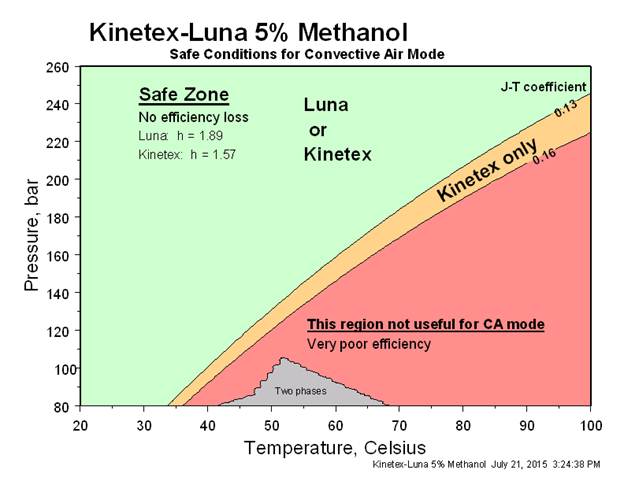Reports: UR951984-UR9: Fluid Flow and Solute Migration in Supercritical Fluid Chromatography
Donald P. Poe, PhD, University of Minnesota (Duluth)
A major objective of this research has been to further develop the theoretical framework for understanding how the hydrodynamics of supercritical fluids percolating through a packed column affect the chromatographically important properties related to retention and efficiency in supercritical fluid chromatography (SFC). During the first year we examined compressibility effects of carbon dioxide-based mobile phases on peak dispersion, on modeling retention and efficiency in SFC, and on development and characterization of instrumentation needed for these studies. We developed explicit approaches to predict the temperature changes along SFC columns during normal operation, and examined the effects of pressure drop and temperature profiles on retention and efficiency in SFC columns. The temperature profiles, and the overall temperature change along the column, are determined by the pressure drop, the Joule-Thomson coefficient of the mobile phase, and by the thermal properties of the column and its environment. In particular, we showed that the temperature drop along a packed column operated under near adiabatic conditions can be calculated from the Joule-Thomson coefficient of the mobile phase and the total pressure drop along the column. These temperature drops have an important impact on column efficiency and peak resolution. In particular, we have shown that the formation of radial temperature gradients at large values of the Joule-Thomson coefficient where there is significant cooling along the column, are the primarily cause of efficiency losses in SFC columns operated under these conditions.
During the second year we performed extensive experimental studies to establish the utility of the Joule-Thomson coefficient as a guide for practical operating conditions in SFC separations. These studies, which utilized a column packed with fully porous particles and operated in a convective air environment, were reported in some detail in the second annual report.
During the third year we extended the previous studies on the impact of the J-T coefficient on efficiency to columns packed with superficially porous particles and operated in convective air thermal environment. As before, we used a mixture of normal alkanes 10 to 18 carbon atoms in length as the test mixture, eluted with carbon dioxide mobile phase containing 5, 10 and 20% methanol. The column was 250 x 4.6 mm ID packed with porous, spherical 5-micron Phenomenex Kinetex-C18 octadecylsilica particles. The solid silica core of these particles results in an increase in the thermal conductivity of the packed bed, relative to the fully porous Luna particles used in the previous study. Due to improved heat transport, the increased thermal conductivity acts to minimize the magnitude of the radial temperature gradients when the column is operated at low pressure and high temperature where the J-T coefficient is large. This makes it possible to operate columns packed with superficially porous particles successfully under such conditions, without loss of efficiency. A guide for onset of efficiency loss, based on a derivation from fundamental principles, has been developed and will be presented in a future publication in a journal such as Journal of Chromatography A. For practical purposes, the value of the Joule-Thomson coefficient at the column outlet provides a more user-friendly guide. A comparison of the useful operating ranges of columns packed with fully porous and superficially porous particles is shown in Figure 1. For each column, the P-T limits for efficient operation are defined approximately by a corresponding J-T isopleth.
We have also developed and tested a specially designed column oven that allows an SFC column to be operated under near-adiabatic conditions. This approach effectively eliminates the radial temperature gradients that lead to efficiency loss for large J-T coefficients, allowing operation of packed SFC columns at much lower outlet pressures than previously possible. Results of these studies will also be published in a journal such as Journal of Chromatography A.
Much of the work performed during the duration of this project was done in collaboration with Professor Georges Guiochon of University of Tennessee Knoxville, and Professor Krzysztof Kaczmarski of Rzeszow University, Poland. Professor Guiochon (d. 2014) was widely recognized as one of the great leaders in separation science, and Professor Kaczmarski is an expert in applying fundamental principles of heat and mass transfer to model physical processes in chromatographic separations. Undergraduate and graduate students performed most of the experimental work, learning the art of experimental design and the necessity of making careful observations and measurements in these exacting studies. Together we have helped to place the science of SFC on a firm theoretical foundation to help guide its future development as a mature separation technique.
Figure 1. Operating zones in SFC using 95% CO2 / 5% methanol as mobile phase. Columns: 250 x 4.6 mm ID with 5-micron Phenomenex Luna-C18 or Kinetex-C18 particles; solute: octadecylbenzene; thermal environment: forced air. Joule-Thomson contour lines in K/bar.












